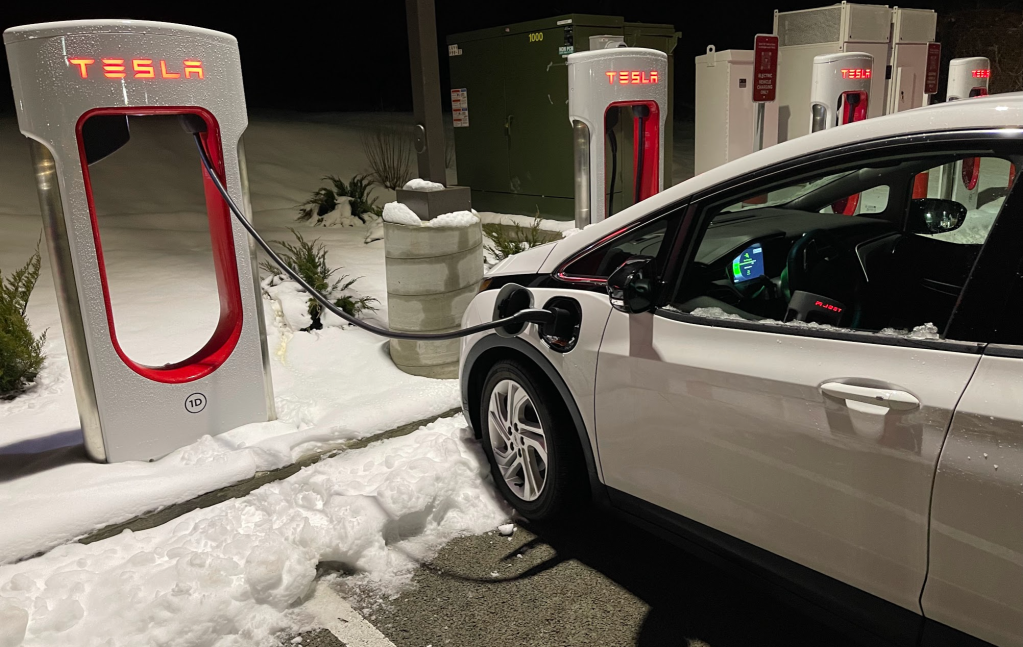
In the midst of the United Auto Workers’ strike, Representative Alexandria Ocasio-Cortez was asked on Face The Nation whether she plans to trade in her Tesla Model 3 for a union-built EV.
However, there really aren’t many EVs she could pick from, and that’s a problem for the Big Three, the UAW, the American auto industry, and US workers in general. And also for AOC.
The UAW started striking two weeks ago, beginning with shutting down one plant at each of the Big Three auto companies. Only one plug-in car was affected initially, the Jeep 4xe.
Since then, the strike has expanded to several more GM and Stellantis parts distribution centers, but the strike against Ford has not expanded as the UAW says talks are progressing better there.
With only one plug-in car currently affected by the strike, it may seem like EVs lucked out, or that the unions perhaps decided not to stop EV production. But in actuality, the reason that union-made EVs haven’t been affected by the partial shutdowns is because, well, there just aren’t very many of them.
What choices does AOC have?
Rep. Alexandria Ocasio-Cortez (AOC) has spoken out repeatedly supporting unions. She’s stood on picket lines in her district and generally supports strikes and labor unions.
Last year, she stated that she wanted to trade in her Tesla Model 3 and get a union-made EV instead. And this weekend, with the UAW striking, she was asked the same question again.
In her answer she mentioned that she purchased her car during the pandemic, looking for safe and efficient travel to DC from her district in Queens, New York. At the time, the Model 3 was the best choice for this – and, frankly, it probably still is, based on fast charging capability, price, range, and general vehicle quality.
But it’s also not union-built, and in addition, Tesla CEO Elon Musk often interferes with unionization efforts and talks down on unions (he even did so yesterday) and routinely acts publicly creepy towards AOC, which is likely a contributing factor to her desire to rinse her hands of the brand.
At the time, the only union-built EV made in the US was the Chevy Bolt. There are more union-built EVs today than there were in 2020 when AOC bought her Tesla, but the choices are still limited.
In the last few years, we’ve seen the Ford F-150 Lightning, the Hummer EV, and the Cadillac Lyriq all go into production here in the US with union manufacturing. But none of those would really be great choices for AOC. Nor would the E-Transit, which is mainly for commercial use, though it paints an amusing #Vanlife image for the congresswoman.
The Lightning and Hummer are far too large for a city dweller, and likely too way much vehicle for her purposes. And the Lyriq, despite being really dang nice, is probably not the right statement for an everyman representative like her – although its $57k base price is almost identical to the $58k MSRP that Long Range Model 3s were fetching at their peak price at the end of last year.
At least, those are some union-made EVs that are built in the United States. If we expand elsewhere, we can find plenty of examples of EVs built by union labor. While foreign automakers typically run non-union shops in the US, they are unionized in their own countries (so, no ID.4 then unless she picks a used, early run model before they switched to Tennessee models). European auto-worker unions are strong (especially in Germany), and Asian automakers are typically unionized domestically even if their unions are not as strong as in Germany. Mexican auto assembly plants are also often unionized, including the one that builds the Mustang Mach E.
But, as a US rep, she is probably looking for a US-made vehicle (and to be fair, she does have the most American-made vehicle already in her Tesla). So even the Mach E from our neighbors to the South is out of the running.
That leaves us the same choice she would have had in 2020: the unassuming but awesome Chevy Bolt. We at Electrek think this is a great choice, having given it our Vehicle of the Year award, and it remains a screaming deal given its low MSRP and availability of credits and incentives to drive that price down further (if you can find one anyway – you can check local dealer inventory here).
A Bolt EUV (due to Super Cruise availability, for that long trip down to DC) is going to be our official recommendation.
But it’s still not ideal for her circumstances, since the Bolt has a slow 54kW DC charge rate. Since Queens and DC are about 240 miles apart, the Bolt’s 247 mile range will likely need a little top-up for safety along the way, and slow DC charge rate and lack of access to Tesla’s superior Supercharger network (though that’s changing soon) will make that experience less than optimal.

Her choices could be getting better soon, with the upcoming Chevy Blazer and Equinox EVs, but those aren’t out yet (though they’re due to hit the road this coming quarter). And her choices will get a little worse at the end of the year as well, since the excellent Chevy Bolt is due to end production in December (though it is slated to come back).
So it’s no wonder she hasn’t been able to trade in her car yet – and that’s kind of a problem.
Electrek’s Take
It’s a problem because it shows that the companies that have formed the industrial backbone of the US for so long are simply not building enough EVs. Everyone understands that EVs are the future of the auto industry – though we at Electrek would argue that they are also the present of the auto industry, not just the future.
Tesla currently has around 5x the combined market cap of Ford, GM, and Stellantis, despite that those three companies combined sell about 10x as many vehicles as Tesla currently. This is obviously a quite… optimistic valuation, but it also shows, among other things, that the market values growth and sees where the industry is going. And it’s clear that investors, as a collective, have more confidence in Tesla’s ability to prepare for the future of the industry than they do in the Big Three combined.
Some, including business media and leadership from the Big Three in the last week or two, blame this on the UAW themselves. The argument goes that unionized labor asks for too much or stands in the way of progress, and that this cripples the Big Three with labor costs and keeps them from being competitive as vehicles evolve, particularly given that EVs will require fewer assembly hours than gas cars.
But as mentioned above, other countries’ automakers have strong auto unions and yet are not similarly “shackled.” And when questioned about whether they might oppose the industry’s green transition due to this drop in assembly hours, UAW leadership has never taken the bait and has merely insisted it be a “just transition.”
Meanwhile, analyses have shown that countries and automakers that don’t fully participate in this green transition aren’t going to do well. We covered a report suggesting Japan’s GDP could drop a full 14% due to its failure to move on EVs. And a year later, we’ve already seen Mitsubishi and Toyota reduce their presence in China due to failure on EVs, and the same goes for other foreign automakers who have underestimated EV demand there.
So everybody knows that we need to go in the right direction, but American automakers have still been slow to offer a wide variety of EV models – despite GM’s promises to the contrary.
The US government has tried to stimulate more production here, via the Inflation Reduction Act, which gives tax credits to domestically-produced EVs. The proposed law originally included an additional union-made credit, but it was struck by the efforts of all 50 republicans and Joe Manchin.
The law has been successful in onshoring production of EVs, as manufacturers have announced investments in domestic EV production totaling in the hundreds of billions of dollars. But it has been less successful in creating union jobs, as many of those announcements are non-union (though we did see the first battery plant unionize late last year and win a pay raise last month).
As I stated in the last article about this, personally, I’m pro-union. And I think that everyone should be – it only makes sense that people should have their interests collectively represented, and that people should be able to join together to support each other and exercise their power collectively, instead of individually.
This is precisely what companies do with industry organizations, lobby organizations, chambers of commerce, and so on. And it’s what people do when sorting themselves into local, state, or national governments. So naturally, workers should do the same. It only makes sense.
Unions are important not just for AOC’s car choices, but for American labor as a whole. The US economy and US workers tend to do better when unionization rates are high, and the auto industry is one of the bulwarks of organized labor in the US and has been central to US manufacturing prowess for decades. This is why AOC supports them, and why President Biden, who joined UAW workers on the picket line yesterday, does as well.
